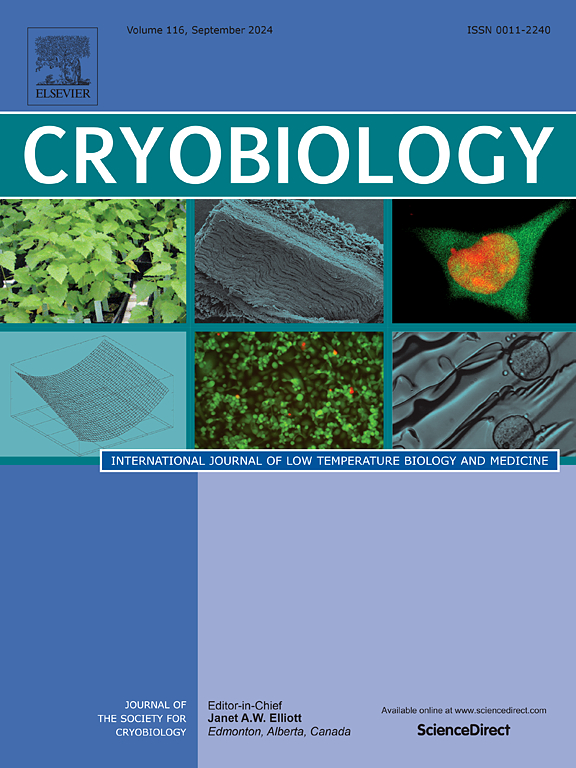The effect of cryopreservation on enamel microcracks – A μCT analysis using a deep learning algorithm
IF 2.1
3区 生物学
Q2 BIOLOGY
引用次数: 0
Abstract
To date, the effect of cryopreservation on microcracks in the dental enamel remains unclear. These enamel microcracks are very thin, at the limit of visibility and their segmentation is beyond the capabilities of traditional image analysis. The objective of the present study was to investigate the effect of cryopreservation on enamel microcracks with a μCT analysis using a deep learning algorithm.
A manual annotation was performed to construct a high-quality training and testing dataset. A 4-phase semantic segmentation U-Net architecture neural network was trained in Dragonfly (ORS systems, Canada) and then applied on a sample of 5 teeth before and after cryopreservation, enabling for the first time a direct evaluation of the formation and evolution of enamel cracks caused by cryopreservation.
Qualitatively, the segmentation results were very satisfying and cracks as thin as 2–3 voxels wide could be segmented automatically. All teeth presented enamel microcracks, without propagation into the dentin. Similar crack patterns were observed in all teeth and may be related to the use of forceps during extraction. In the post-cryopreservation scans the damage extended, and new smaller cracks appeared on the occlusal surface of the tooth. Quantitatively, the average crack/enamel ratio was 0.066 ± 0.021 % before cryopreservation, and 0.087 ± 0.018 % after cryopreservation.
The present study presents the first scalable yet precise method to quantify clinically relevant tooth damage after cryopreservation. As such, this method also opens the way to future in-depth studies on dental enamel in many dental fields.
低温保存对牙釉质微裂纹的影响——基于深度学习算法的μCT分析。
迄今为止,冷冻保存对牙釉质微裂纹的影响尚不清楚。这些牙釉质微裂纹非常薄,在可见性的极限下,它们的分割超出了传统图像分析的能力。本研究采用深度学习算法,通过μCT分析研究低温保存对牙釉质微裂纹的影响。通过手工标注构建高质量的训练和测试数据集。在Dragonfly (ORS系统,Canada)上训练了一个四阶段语义分割U-Net架构神经网络,并将其应用于冷冻保存前后的5颗牙齿样本,首次能够直接评估冷冻保存引起的牙釉质裂纹的形成和演变。定性地说,分割结果非常令人满意,薄至2-3体素宽的裂缝可以自动分割。所有牙齿均出现牙釉质微裂纹,未向牙本质扩展。在所有牙齿中观察到类似的裂纹模式,可能与拔牙时使用镊子有关。在冷冻保存后的扫描中,损伤扩展,并且在牙齿咬合表面出现新的较小的裂缝。从数量上看,冷冻前的平均裂纹/牙釉质比为0.066±0.021%,冷冻后的平均裂纹/牙釉质比为0.087±0.018%。本研究提出了第一个可扩展且精确的方法来量化冷冻保存后临床相关的牙齿损伤。因此,该方法也为今后在许多牙科领域对牙釉质的深入研究开辟了道路。
本文章由计算机程序翻译,如有差异,请以英文原文为准。
求助全文
约1分钟内获得全文
求助全文
来源期刊

Cryobiology
生物-生理学
CiteScore
5.40
自引率
7.40%
发文量
71
审稿时长
56 days
期刊介绍:
Cryobiology: International Journal of Low Temperature Biology and Medicine publishes research articles on all aspects of low temperature biology and medicine.
Research Areas include:
• Cryoprotective additives and their pharmacological actions
• Cryosurgery
• Freeze-drying
• Freezing
• Frost hardiness in plants
• Hibernation
• Hypothermia
• Medical applications of reduced temperature
• Perfusion of organs
• All pertinent methodologies
Cryobiology is the official journal of the Society for Cryobiology.
 求助内容:
求助内容: 应助结果提醒方式:
应助结果提醒方式:


